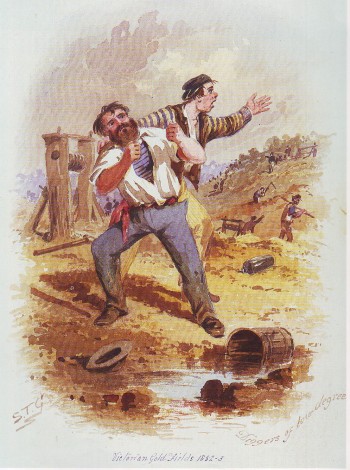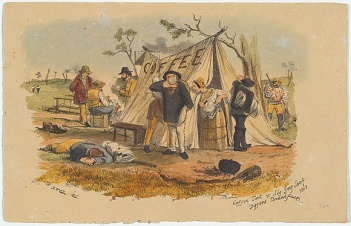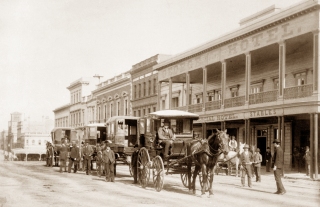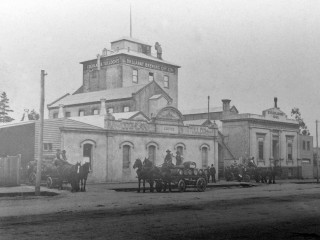Where and what did diggers drink?
This blog was inspired by a speech given by our CEO, Dr Jeremy Johnson in April 2010 at the University of Ballarat Beer Awards. The speech was based on research done by Sovereign Hill’s Senior Historian, Dr Jan Croggon. The speech was recorded and an audio file is available at the end of this blog.
The problem of alcohol and young men
The colonial government of Victoria was incredibly worried about alcohol on the goldfields. The population of Victoria before 1860 was mainly young men, and the authorities were concerned that over indulgence in alcohol could lead to a breakdown in law and order in the colony. For that reason an act was passed to prohibit alcohol from being sold on the goldfields. This act allowed for harsh penalties if you were caught manufacturing or selling liquor. A first offence carried a £50 fine, whereas threatening with a pistol might only incur a fine of £5. The Act was policed by plain clothes men, who were given half of the £50 fine for a first offence, and then, because a second offence brought months of hard labour, and no profit for the police, they resorted to blackmail, taking £5 whenever they felt like it.
Sly Grog
Alcohol was a fundamental part of life on the Victorian goldfields. Part of the reason many miners turned to alcohol as their drink of choice was because the available water quickly became so foul and polluted that drinking it could prove lethal. Diarrhoea, dysentery, cholera and typhoid were all contracted by anyone foolish enough to drink the local creek water. Prohibition seemed to merely enliven the situation, giving unscrupulous and enterprising individuals the opportunity to capitalise on the Great Thirst of the hard working gold miners.
Sly grog searches became an excuse for law enforcers to reap extra money, and indulge their often frightening tendencies to violence. The legal requirements for a sly grog search did NOT require them to burn down tents, but only to seize illegal liquor, together with the means of manufacturing it, and apprehending the offender. Superintendent Armstrong was one authority who became notorious for the viciousness and violence of his attacks on sly grog merchants. He bragged to Lord Robert Cecil of how at Ballarat he had ordered the tents of alleged sly-groggers to be stuffed with dry timber and set ablaze, destroying them ‘rump and stump’. The occupants lost everything; not just the alleged merchandise, but furniture, bedding, personal effects, and the roof over their heads.
Despite the harsh penalties, sly grog shops sprang up all over the diggings, posing as stores and soup kitchens. Such establishments were often run by tough, uncompromising women – for example, Charles Thatcher’s ‘Big Poll the Grog Seller’:
Big Poll the Grog seller gets up every day,
And her small rowdy tent sweeps out;
She’s turning in plenty of tin people say,
For she knows what she’s about.
Polly’s good looking, and Polly is young,
And Polly’s possessed of a smooth oily tongue;
She’s an innocent face and a good head of hair,
And a lot of young fellows will often go there;
And they keep dropping in handsome Polly to court,
And she smiles and supplies them with brandy and port,
And the neighbours all say that the whole blessed day
She is grog-selling late and early.
Terence Fitzsimons, our Honorary Musicologist has recorded this song for the blog. Click on the player below to listen.
Mrs Ellen Clacy, who toured the goldfields of Victoria. Wrote in her book, “A Lady’s visit to the Gold Diggings of Australia in 1852-1853”:
“there is more drinking and rioting at the diggings than elsewhere, the privacy and risk gives the obtaining it an excitement which the diggers enjoy as the spirit itself.”
Mrs Clacy also described the ‘amiable female’ – a horrendous person encountered on her trip around the diggings.
“… whilst her husband was at work farther down the gully, she kept a sort of sly grog shops, and passed the day in selling and drinking spirits, swearing, and smoking a short tobacco-pipe at the door of her tent. She was a most repulsive looking object. A dirty gaudy-coloured dress hung unfastened about her shoulders, coarse black hair unbrushed, uncombed, dangled about her face, over which her evil habits had spread a gentle bacchanalian glow, whilst in a loud masculine voice she uttered the most awful words that ever disgraced the mouth of man – ten thousand times more awful when proceeding from a woman’s lips.”
Bachannalian is an old term for drunkenness. It originates from the Roman term for a festival honoring Bacchus, the God of Wine.
To listen to audio versions of other quotes about the goldfields, go to our goldfields quotes page or our audio library.
What sort of alcohol was available on the early diggings?
Much of the sly grog was a very dodgy mixture of illicit spirits, with a selection of whatever was to hand, to complete the somewhat dubious concoction. A government inquiry into the sly-grog industry in 1853 uncovered the fact that ‘brandy’ was laced with additives like tobacco and pharmaceutical spirits. A cocktail called ‘Blow My Skull Off” was found to contain ‘Cocculus indicus, spirits of wine, Turkey opium, Cayenne pepper, and rum, plus five times the quantity of water! Imagine what damage this concoction of dangerous substances would do to your health!
.
In the earliest days of the gold rush, spirits were more commonly consumed, simply because the problems involved in supplying enough drinkable beer were large. Beer tended to deteriorate rapidly with age, and during the gold rush, the population moved around constantly, which made the job of suppliers more difficult. Because of this, it was easier to supply them with spirits than with beer. Until late in the 19th century beer drinking was mainly done in larger towns and cities.
Hotels in Ballarat
It was June 1853 before the first legal source of alcohol appeared in Ballarat. This was Bath’s Hotel. By May 1854, central Ballarat had 22 hotels, including four in the township. The George and Bath’s were the best known. 18 hotels were on the diggings, including Bentley’s, the Charlie Napier, the Star, and the US Hotel. By 1858, the increased number of hotels was a marvel to behold: 31 of 142 identifiable properties – or almost every fourth building – was a hotel!
The Brewing Industry
The gold rushes certainly stimulated the growth of the brewing industry. In the decade 1851 – 1860, in NSW, the annual average consumption was 4.4 gallons, compared with gold rich Victoria, which was almost double in its consumption – 8.1 gallons. This was predominantly imported beer.
The long sea voyage and the extremes of temperature involved badly affected the quality of imported beers, and so local breweries were established. W B Withers in his “History of Ballarat” writes that by the 1870s, there were four commercial breweries in the city, as well as the Warrenheip Distillery which was famous for its spirits. From the 1850s, the growth of breweries in country towns, more rapid transport as a result of the spread of the railway network, and an increased production of bottled beer, all helped to bring a better quality drink within reach of more people.
Local brewing was a fledgling industry – kick-started by the discovery of gold, and the need to minister to this afore mentioned Great Thirst. The large industrial brewers have long since stopped production in Ballarat, but beer production does continue due to the growth of the microbrewery industry. By the way, the water supply is much better in Ballarat now, you don’t need to drink alcohol to stay healthy anymore.
As stated at the beginning, this post was inspired by a recording of a speech made by our CEO, Dr Jeremy Johnson in 2010. You can listen to a recording of this speech by using the player below.













Pingback: Boozy Ballarat – Gold Museum, Ballarat